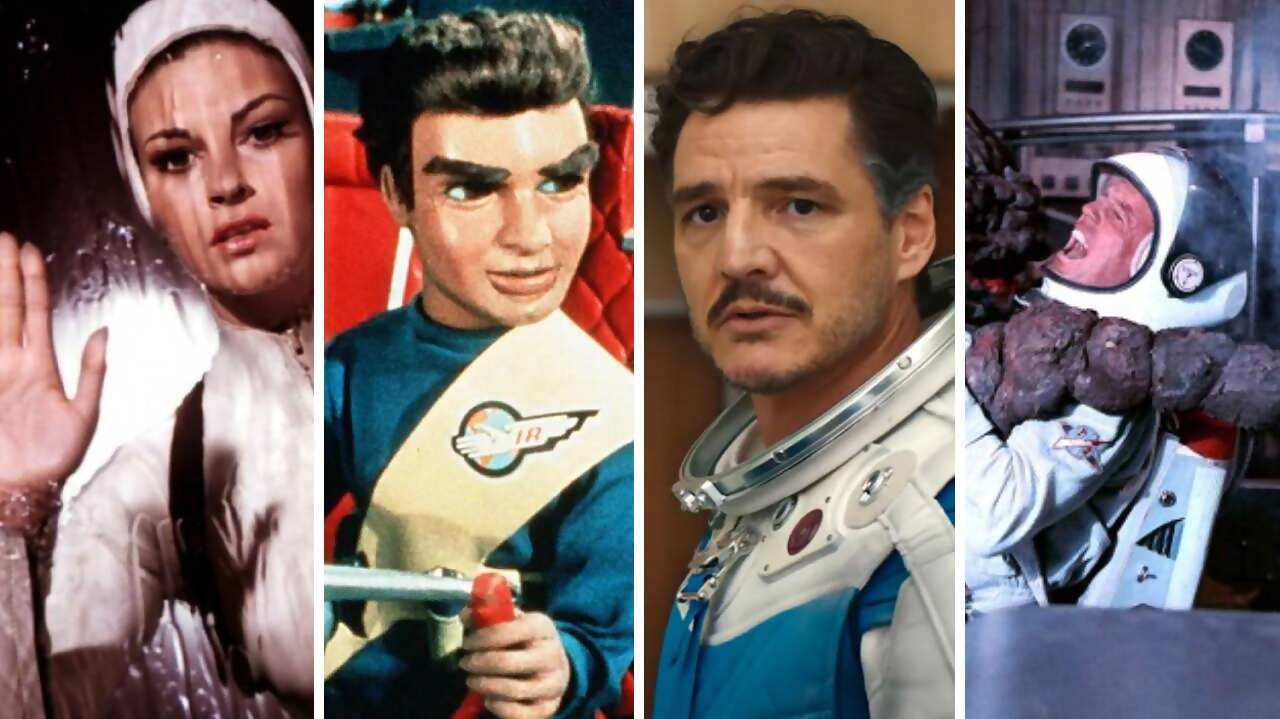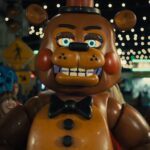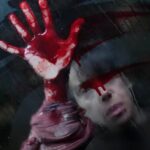
If The Fantastic Four: First Steps left you hankering for more sci-fi films with similar themes, here’s our pick of 10 classics.
Marvel’s latest film outing, The Fantastic Four: First Steps, may herald the beginning of Phase Six, but it also sees the MCU look back to the past. Bringing the comic book to the screen a decade after 2015’s ill-fated Fantastic Four, director Matt Shakman and his team have emphasised the source’s colourful 1960s roots, as originally drawn by artist Jack Kirby.
While hardly short on action and extensive public property damage, The Fantastic Four also tells a story about family and the terrifying uncertainty of parenthood. And it must be said that the 60s-themed production design – all amorphous curves and chrome detailing – looks good enough to eat.
So if the upbeat, 1960s stylings of Shakman’s film left you keen to see a few more sci-fi along similar lines, here are 10 retro recommendations…
The Quatermass Xperiment (1955)
Fantastic Four creators Jack Kirby and Stan Lee may not have been familiar with this movie when they came up with their comic book concept in the early 1960s, but there are one or two fascinating parallels between their work and this sci-fi classic. Based on Nigel Kneale’s TV series The Quatermass Experiment (the X is to emphasise its old adults-only age rating), it’s about a British-US effort to put a rocket into space. The launch goes off without a hitch, but when the vessel returns to Earth, it’s discovered that something awful has happened to the three astronauts aboard. Brian Donlevy stars as the titular Professor Quatermass, who has to stop a threat that soon grows to city-threatening proportions. Even at 60 years old, this is still a gripping nail-biter. Released in the US as The Creeping Unknown.
Thunderbirds Are Go (1965)
A space mission gone awry. Cool rockets and gadgets. A flying car. Loads of buildings exploding. Thunderbirds Are Go may have puppets rather than superheroes, but this lavish film spin-off from Gerry Anderson’s hit TV series has a similar sense of optimism and adventure to The Fantastic Four. Its curvaceous, utopian production design and vibrant colour palette are also akin to Marvel’s latest opus – the First Family favour a shade of blue remarkably close to the tone worn by International Rescue in Thunderbirds. Just to underline the 1960s Cool Britannia feel, Thunderbirds Are Go also features a cameo (and several songs) by Cliff Richard and The Shadows, albeit in Supermarionation form.
Fantastic Voyage (1966)
Here’s a pulpy adventure that positively screams 1960s style. When a politician is left mortally injured following an assassination attempt, a crew of specialists is shoved into a submersible craft, shrunk down to the size of a grain of sand, and injected into the victim’s blood stream. There are lots of superhero-like tight suits, some quite neat (and Oscar-winning) special effects, plus Donald Pleasance, sent aboard to ruin everyone’s day. Director Joe Dante made his own take on the same concept with the underrated Innerspace (1987).
The Green Slime (1968)
For a quintessentially 1960s sci-fi adventure, look no further than this B-movie classic. It’s possible that director Matt Shakman and his team looked to this film’s kitsch production design ahead of making The Fantastic Four. Directed by Kinji Fukasaku, The Green Slime sees a group of astronauts save Earth from a comet, only to face a much worse (and gooey) extra-terrestrial threat aboard their space station. It’s all utter nonsense, but thoroughly joyful nonsense – and quite creative from a visual standpoint. It also has an infectious swinging sixties theme song – something The Fantastic Four sadly lacks. Green sliiiiiiime…
Marooned (1969)
If The Green Slime was a little too kitsch for comfort, then director John Sturges’ sci-fi thriller offers a more sophisticated view of space exploration. As the title implies, it’s about a group of astronauts whose mission goes wrong, leaving NASA to figure out how to get the crew back to Earth. There’s a superb cast, including Gene Hackman, Gregory Peck and Richard Crenna, but that couldn’t save Marooned at the box office, where it withered as Stanley Kubrick’s 2001: A Space Odyssey, after a slow start, soared. Admittedly, none of the space adventurers here end up with superpowers, but this is still an under-seen sci-fi gem from the 1960s that’s worth tracking down.
Eraserhead (1977)
Rather heavier than the films discussed so far, David Lynch’s feature debut has one clear thematic connection to The Fantastic Four: First Steps – parental anxiety. Just as Pedro Pascal’s Reed Richards frets about the uncertainty of becoming a father, so the protagonist in Eraserhead lives through a waking nightmare about adult responsibility. Richards responds to his impending dad status through incessant over-planning; Jack Nance’s luckless Henry is essentially trapped in his own retro Americana hellscape of unhinged in-laws and grotesque babies. If this entry seems like a bit of a stretch (pun intended), just be grateful we didn’t go for The Baby of Mâcon instead.
Transformers: The Movie (1986)
Galactus isn’t pop culture’s only planet-eating villain. In 1986, unsuspecting kids everywhere were introduced to Unicron – a vast, transforming robot that consumes entire worlds for breakfast. (Unicron was, of course, voiced by the great Orson Welles in one of his final ever roles.) Featuring some terrific hand-drawn animation by Japanese studio, Toei, and a rocking soundtrack by Vince DiCola, Transformers: The Movie is as steeped in 1980s style as The Fantastic Four is in the 1960s. It also famously killed off a lot of popular characters, leaving a generation of kids aghast.
The Fly (1986)
The same month kids were weeping over the death of their favourite Autobot, older-audiences were left agog at the sight of Jeff Goldblum puking on a donut. David Cronenberg’s squidgy body horror aside, The Fly is essentially a romantic tragedy on fast-forward, with Goldblum and Geena Davis both outstanding as the lovers torn apart by an experiment gone wrong. Beyond the relationships and brief ponderings on parenthood, The Fly’s more obvious connection to The Fantastic Four is its matter teleportation technology. Reed Richards appears to be a teetotaller, though, so his research into moving an egg from one place to another is far less calamitous than Goldblum’s. Remember: don’t drink and operate experimental machinery, folks.

Suggested product
SPECIAL BUNDLE! Film Stories issue 54 PLUS signed Alien On Stage Blu-ray pre-order!
£29.99

The Abyss (1989)
James Cameron’s follow-up to Aliens is a heady cocktail of lofty first-contact sci-fi and low-key relationship drama. The special effects and practical underwater photography are stunning, but what makes The Abyss so effective is the interplay between Ed Harris’s blue collar foreman Bud and his more intellectual, estranged wife, Lindsey, played by Mary Elizabeth Mastrantonio. As in The Fantastic Four, the spark of chemistry and realism between the leads helps sell the pulpier elements in the plot.
Independence Day (1996)
Aliens in massive craft threatening Earth’s landmarks, and heroes coming up with a last-ditch plan that might… just… work. In fusing the 1950s sci-fi of Earth Vs The Flying Saucers with the ensemble narrative of a 1970s disaster flick, director Roland Emmerich set the tempo for modern blockbusters that still plays on in the 21st century. Like The Fantastic Four, Independence Day is also an entertainingly camp adventure about pulling together in the face of a planet-wrecking alien threat. “Let’s nuke the bastards!”
The Fantastic Four: First Steps is in UK cinemas now.




